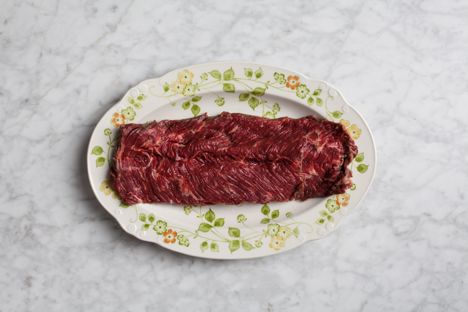
Skirts and shins: the underrated cuts of beef
They're a lot more affordable than the more famous prime cuts, but don't let that put you off – with the right care and attention, lesser cuts are the most flavourful part of the animal.
Skirts and shins: the underrated cuts of beef
They're a lot more affordable than the more famous prime cuts, but don't let that put you off – with the right care and attention, lesser cuts are the most flavourful part of the animal.
It’s usually considered unfortunate that we can’t afford premium cuts as much as we like. The thing is, it’s often the butcher’s cheaper and less in demand beef cuts that are the most flavourful.
The flipside? A lot more care and attention when cooking. But don’t let that put you off – here we’ve rundown some of these lesser cuts, and the best ways to get bags of flavour out of them.
The cuts
More widely used in French brasseries as steak frites, onglet – or ‘hangar’ steak if you prefer – is slowly but surely catching on in other parts of the world for its intense flavour. This cut is taken from near the liver, within the skirt, and as such is one of the most tender parts of the animal.
How to cook onglet: The best way is the only way – cooked in a pan over high heat to rare or, at most, medium rare.
Shin is a bargain at the butcher’s, but with the high amounts of nerves and connective tissue it has, maybe that’s not surprising. Still, when cooked for several hours, those all render down, leaving you with a meltingly soft piece of beef.
How to cook shin: Braise for use in curries and stews, such as beef bourguignon.
Brisket is from the lower chest of the animal. Due to its location between the neck and leg, there’s a lot of muscle within the meat. But that’s not to say it doesn’t have a lot of flavour when cooked right, as any fan of traditional Texas barbecue will tell you.
How to cook brisket: Low and slow. After marinating or rubbing the meat with spices, leave in a slow cooker for several hours or smoke gently over a charcoal or wood fire.
Gets its name from the ‘silverwall’ removed from the side of the cut during butchering. In other parts of the world, it’s common to see this cut used to make corned beef, though in the UK we usually reserve it for roasting.
How to cook silverside: This cut tends to come in two forms – either rolled up and string tied, or as a ‘salmon’ cut. The former’s good as a more affordable roasting joint, while the latter is best cooked in a slow cooker.
Also known in the UK as braising steak, chuck is a rich piece of meat with a good meat-fat balance. Because it’s a well-used part of the animal however, it also possesses a certain toughness. This call for a bit of the old low and slow treatment.
How to cook chuck: More commonly sold as a braising steak now days, chuck works well in a simple casserole dish too.
Once discarded at the abattoir, bavette – also known as thick flank or goose skirt – is a well-textured and versatile cut from the belly of the animal.
How to cook bavette: Either slice into ribbons, flash fry and serve rare, or stick it in a casserole as a much more tender option.
Fatty and bony, oxtail – an anachronism of cow tail – is almost the furthest you can get from a prime cut. But all that fat does have its uses, namely when boiled down into wintery dishes like stews and soups.
How to cook oxtail: Because of its high collagen content, and just like other cheaper cuts, oxtail can’t be cooked quickly over intense heat or the meat will simply toughen up. With the option of braising the meat, introduce it straight into a stew, saving any extraneous juices for stock.
With all that chewing, a cow’s cheeks are among the toughest part of the animal. The growing popularity of nose-to-tail restaurants however has put them more into the mainstream of late. Best to not get too cheeky with your butcher – this cut isn’t commonly stocked, so neglecting to call ahead of a visit could lead to disappointment.
How to cook cheek: As it’s a typically rich cut, braise a reasonable portion of meat in wine or a full-bodied ale for an indulgent fireside supper.


